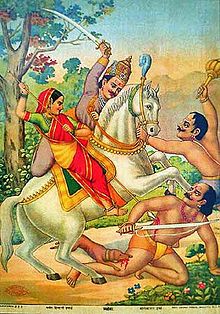
Back خاندوبا Arabic খন্ডোবা Bengali/Bangla Khandoba Danish Khandoba German کاندوبا Persian Khandoba Finnish खंडोबा Hindi ꯈꯟꯗꯣꯕꯥ MNI खंडोबा Marathi ਖੰਡੋਬਾ Punjabi
| Khandoba | |
|---|---|
 | |
| Sanskrit transliteration | Khaṇḍobā |
| Devanagari | खंडोबा |
| Affiliation | Avatar of Shiva |
| Abode | Jejuri |
| Mantra | Om Shri Martanda Bhairavaya Namah |
| Weapon | Trishula, Sword |
| Mount | Horse |
| Consort | Mhalsa and Banai (chief consorts) |
Khandoba (IAST: Khaṇḍobā), also known as Martanda Bhairava,, Malhari,Mylaralinga,Bandarada Odeya and Malhar, is a Hindu deity worshiped as a manifestation of Shiva mainly in the Deccan plateau of India, especially in the state of Maharashtra and North Karnataka. He is the most popular Kuladevata (family deity) in Maharashtra.[1] He is also the patron deity of some warrior, farming castes, shepherd community and Brahmin (priestly) castes as well as several of the hunter/gatherer tribes that are native to the hills and forests of this region. The sect of Khandoba has linkages with Hindu and Jain traditions, and also assimilates all communities irrespective of caste, including Muslims. The form of Khandoba developed during the 9th and 10th centuries from a folk deity into a composite god possessing the attributes of Shiva, Bhairava, Surya and Kartikeya (Skanda). He is depicted either in the form of a linga, or as an image of a warrior riding on a bull or a horse. The foremost centre of Khandoba worship is the temple of Jejuri in Maharashtra. The legends of Khandoba, found in the text Malhari Mahatmya and also narrated in folk songs, revolve around his victory over demons Mani-malla and his marriages.
- ^ Singh p.ix